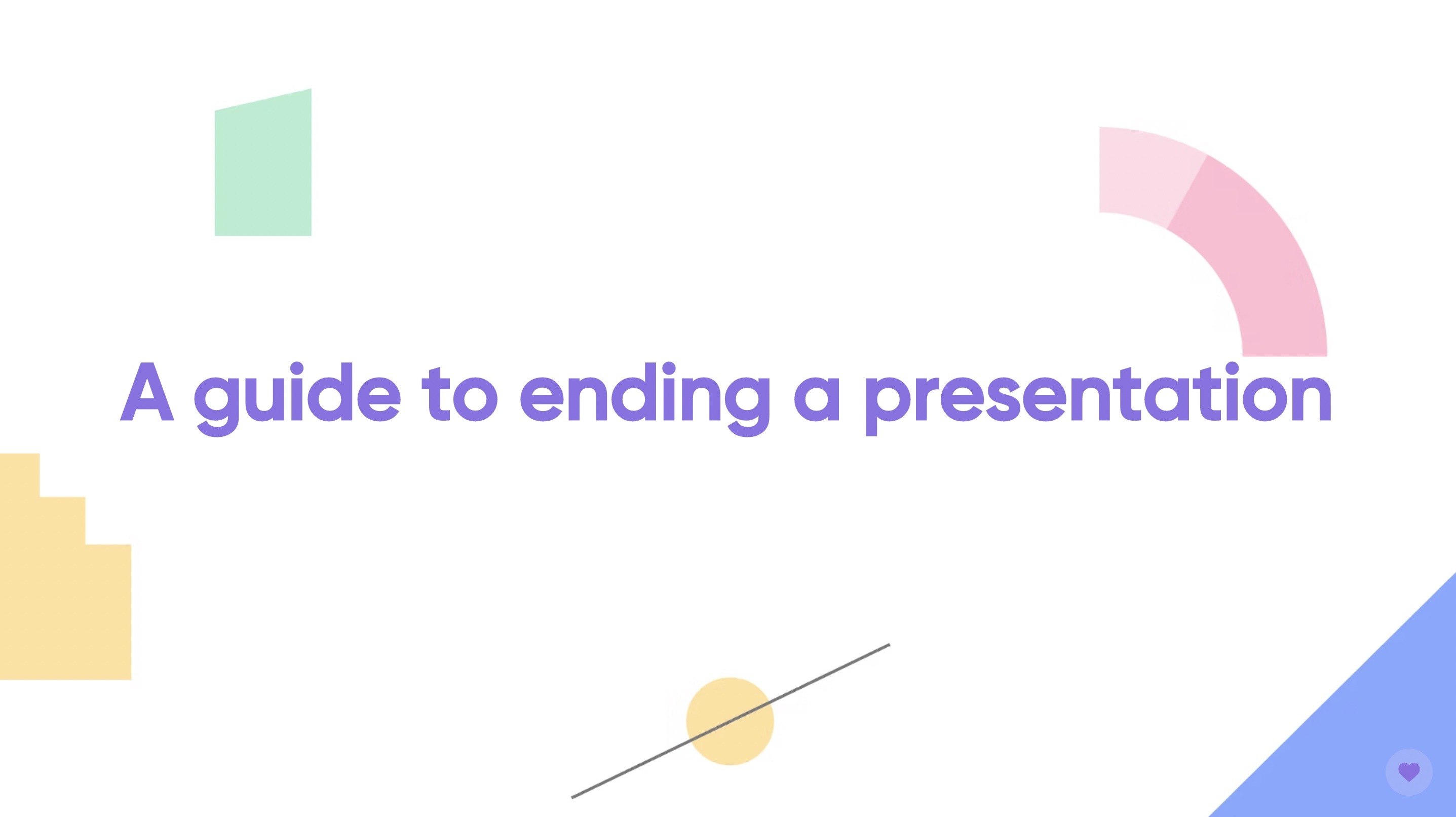Reaching the end of a presentation is a milestone in itself but it’s now time to finish what you started and end with a bang or a flourish (depending on which you prefer). But what are the best ways to wrap up a presentation and what tools are out there that can help you end on the right note?
So you have overcome that initial bout of nervousness and jitters that you felt when you began to present (If not, check out our public speaking course). You then proceeded to masterfully articulate each and every one of the points you wanted to hit. Now what . . . Well, we have thought about this ourselves and we know that ending your presentation can be tricky as we often focus so much on how we want to break the ice or about the content we will include in the middle.
Finishing a presentation strong will help to leave your audience suitably impressed and have all of your key points and arguments reverberating around the heads long after they leave the meeting, the classroom, or Zoom call. You have done all the hard work up until this point so time to put the cherry on top of this sundae, so we have come up with a number of different ways you can end your presentation and some of the best tools you can use to both improve your presentations and their endings.
So let’s look at some tips first of all.
- Run a live poll
- Call them to action
- Reverse icebreaker
- A strong summary
- Give them a survey
- Avoid a Q&A
- End with a story & infographic
- Show a visual or short video
- Add an important statistic
Run a live poll
If you want to engage with your audience and gather some live feedback, then there is nothing better than a live poll. There are plenty of ways to conduct a poll, but using a presentation tool can often be the easiest and most efficient way to do so. Polls are the ideal way to understand your audience better, help break the ice at the begging of a presentation, or collect feedback on how the presentation went and what you can do to improve for next time.
Call them to action
So many great speakers around the globe will always highlight the importance of including a call to action at the very end of your presentation. If you are running a presentation that is intended to either inspire or educate your audience then you want them to leave this meeting with a clear message. Much like a webpage, CTA may seek to inspire visitors to register or sign up, you want your CTA to inspire action.
Reverse icebreaker
So we mentioned icebreakers before, and they can be a good way to warm up the crowd or to calm your own nerves. Icebreakers come in a variety of shapes and sizes but need not be confined to the very beginning of the meeting. Perhaps you want to end on a more jovial note or want to let your audience have the last word, no matter, you can adjust the icebreaker to suit your needs. One interesting thing to do could be to run an icebreaker similar to the one you started with but adding in some unique spin!
A strong summary
Some presentations will be longer than others, some need to be full of detail, and some will be short quick hitters. Regardless of which type of presentation you are running giving your audience a strong and succinct summary of your key takeaways will help them recall what you said at the start just as well as those towards the end.
Give them a survey
Engaging with your audience is always a good idea no matter what the situation happens to be. Thus, surveying them or giving them the opportunity to provide their opinions and thoughts can be the best way to interact and hear what they have to say. This can of course be done live or you can compel them to go off and provide their responses once the curtain closes on your time.
Avoid a Q&A
Q&As tend to be left until the very end. But try and avoid this habit we all have of looking to the audience for questions and feedback right at the very end. You always want to hear from your audience but remember that this is your presentation and you want to end it on your terms and with your words. Feel free to run a Q&A towards the end but be sure to take back some level of control so you can wrap things up on your terms.
End with a story & infographic
A story can be a great way to wrap up a presentation and provide some significant context to help your audience better comprehend and better remember what you were discussing. However, stories can be long and you run the risk of losing people along the way. Obviously, you can break up the story and make sure it’s not overly long or complex. This means you run the risk of dumbing things down and oversimplifying matters.
Why not give the audience a visual aid to help them follow along in the form of an infographic? You can simultaneously list the key points of the story, and add relevant graphics to highlight other teaching or focus points.
Show a visual or short video
This could be a product demo, a poignant advertisement, a pertinent figure giving a speech, or anything else you think could be relevant to your audience. A video or some form of visual can be especially useful if your presentation was text or speech-heavy. Likewise, if you used plenty of interactive elements it can be good to diversify the content you include in your presentation, and ending with some visual stimulation can be the best way to do this.
Add an important statistic
Many presenters often finish with a quote, the issue with this however is that you give someone else the last word. Ideally, your words should be the ones that resonate with your audience and the ones that stick with them even after the curtain comes down on your presentation. If you want to include a quote think about doing so in the middle of the presentation are a poignant moment.
Why not use a statistic instead? This can help to validate your arguments, highlight the pressing importance of the topics you covered, or help spur your audience to action. Stats and metrics can be a really useful tool when sprinkled into a presentation rather than the dominant force. Ending with one can be the most effective way to include one.
Now that we have looked at ways you can end your presentation, it’s time for the tools!
- Mentimeter
- Venngage
- Animoto
- RAWGraphs
Mentimeter
If you’re looking to add in an icebreaker, poll, or survey then Mentimeter has all the capabilities and slide types you could possibly need. We have spoken above about how beneficial it can be to finish off your presentation with an engaging and interactive element and use a tool that will quickly and easily. You will therefore need a tool that can combine all of these elements but make the voting process easy for your audience.
The last thing you want to do is finish off your presentation with some needlessly complex and inefficient way of asking your audience a simple question of series of questions. Thankfully this won’t be the case here as your audience can jump onto their phones - it’s the end of the presentation too and we all know they’re begging for the chance to get back to scrolling - and quickly provide you with their thoughts, opinions, and feedback.
Here's a free template you could use for running a post-presentation survey.

Post-Event Feedback Survey
Venngage
If you want to end with a flourish and a stunning-looking visual or comprehensive infographic then look no further than Venngage. Thanks to a wide variety of designs, as well as a vast collection of templates to help you get started, you can jump right in a create something that is both custom and impressive. We have mentioned that infographics can be a great way to illustrate both your final story and your end summary, so why not make said infographic equally memorable by using a tool that helps with the design side of things?
Animoto
Including a final video can be a fantastic way of rounding off a presentation but this depends on finding the right source material online - probably on YouTube. Animoto takes the hassle and time out of searching for the right video by letting you create your own. If you are using your own footage then simply add clips together, edit the footage, and set the transitions, colors, and even the music. Not only can you end with a nice visual element but you can likewise customize it and edit it to make it tailored and suited to your exact needs.
RAWGraphs
Last but not least we have RAWGraphs. Creating enlightening and vibrant charts and graphs can be difficult if using one of the more traditional tools like Excel or PowerPoint. RAWGraphs lets you input your data and customize your chart and graph to your looking. This is a great way to add in a nice chart showing off some analytics of insightful information but doing so in a way that is visually appealing and attention-grabbing.
Plenty of tools and tricks
So now that we have given you all the information you need to end your presentation I guess it is time for me to end this particular blog post. Remember that ending your presentation with a flourish and something memorable is a great way to have your audience thinking about everything you said long after the meeting.



